As an Amazon Associate, I earn from qualifying purchases with no additional costs for you.
The classification of rocks is indeed crucial in order to organize the vast amount of information about rocks that have accumulated throughout the existence of our civilization. It enables us to address important tasks such as rapid identification of rocks based on their characteristics, prediction of rock properties, understanding geological processes in specific regions, and much more.
The main division of rocks is based on their genesis into three groups: igneous, metamorphic, and sedimentary rocks. These groups are further divided based on characteristics such as texture, mineral or chemical composition, and the method or location of formation.
In this article, we’ll walk you through the different rock classification systems, the specific rocks that belong to each group, and the parameters by which rocks are grouped together. We will also discuss the most common criteria used by geologists to classify rocks and provide examples of different types of rocks.
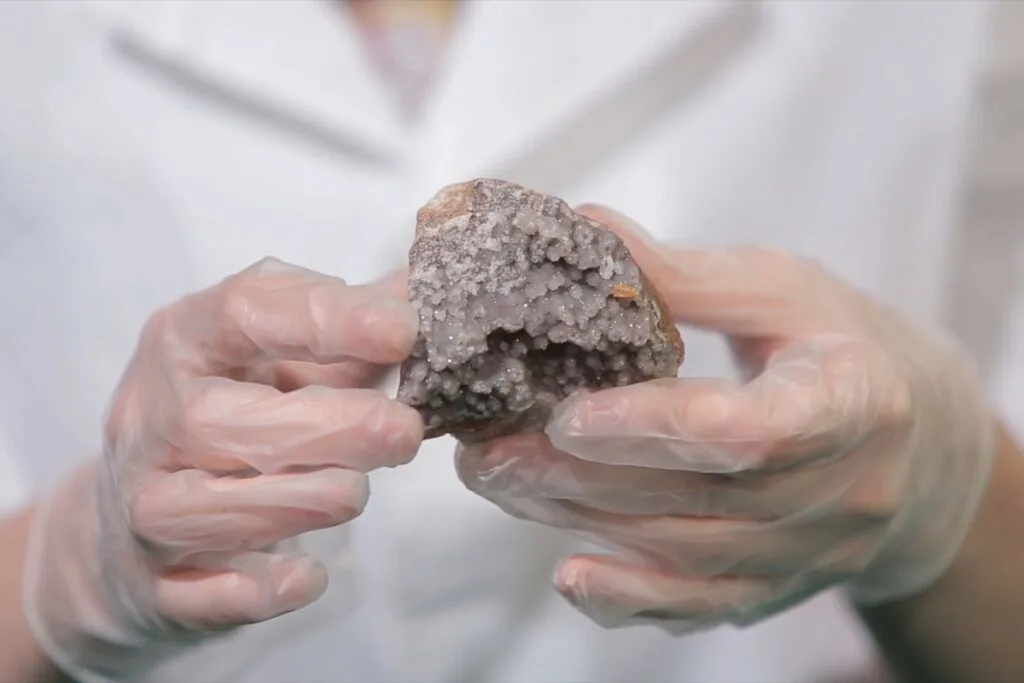
If you are interested in checking out the best books about rock and minerals identification you can find them by clicking here (Amazon link).
Why Do Geologists Classify Rocks Into Groups?
Scientists from various fields of science have encountered the challenge that when a data set grows to a large size, it becomes necessary to systematize the information by dividing the data into groups and subgroups based on common characteristics.
Here’s a simple but understandable example of why information is organized into a system: imagine that you need to find specific information in a thick book.
However, the pages of this book are not numbered, and the book itself is not divided into paragraphs. In this case, your task would be extremely difficult. But if the pages are numbered, and the book is divided into paragraphs, you can easily find the information you need.
The same principle applies to a large data set of information about rocks. Over the course of human history, a significant amount of information has been accumulated regarding rocks.
By organizing and classifying this information, it becomes much easier to navigate, search, and extract relevant knowledge about rocks.
The first descriptions of rocks can be traced back to ancient civilizations that had an interest in studying the Earth and its geological features. One notable figure is Theophrastus, a Greek philosopher, and student of Aristotle, who wrote a treatise called “On Stones” around 300 BCE.
This work is considered one of the earliest known systematic descriptions of rocks and minerals. Theophrastus classified rocks based on their physical properties and provided observations on their formation and occurrence.
As we can see, the need for systematizing knowledge about rocks arose thousands of years ago. Nowadays, there are various classification systems for rocks based on different characteristics, and they serve specific purposes, such as:
- Identification of rock types: when a geologist encounters a rock, they need to identify it correctly. To do this, the geologist examines various physical and chemical characteristics of the rock. By utilizing a classification system for rocks, the geologist can determine the name of the rock and gather other information about its type.
- Prediction of rock properties: by identifying the rock and determining its rock type, one can infer the properties associated with that particular rock type. This is particularly important in engineering geology, as different rock types have varying load-bearing capacities, permeability, and other relevant properties.
- One common language for geologists: Classification provides a standardized system for geologists to communicate and share information about rocks. By using common classification schemes, geologists can convey information about rocks more effectively, enabling clearer communication within the scientific community and facilitating the exchange of knowledge.
- Predicting resources: Different rock types have varying economic significance and may contain valuable resources such as minerals, ores, or fossil fuels. Geologists can identify potential resource-bearing formations and predict their distribution by classifying rocks. This information is crucial for exploration and mining industries to locate and extract valuable resources efficiently.
- Geological mapping: Classification helps in the creation of geological maps that provide a visual representation of rock types and their spatial distribution. These maps help geologists understand the geology of an area, including its structure, stratigraphy, and potential geologic hazards. Geological maps are essential for land use planning, infrastructure development, and environmental management.
- Understanding Earth’s history: Rocks record Earth’s geological history. By classifying rocks into groups, geologists can interpret the processes that formed them, such as volcanic activity, sedimentation, or metamorphism. The study of rock groups allows geologists to reconstruct past environments, understand tectonic processes, and unravel the complex history of our planet.
In general, the classification of rocks by geologists serves as the basis for understanding the history of the Earth, communicating scientific information, and making informed decisions in various fields related to earth sciences, including geology.
TIP: There are various methods available to determine the age of rock. Check them out in the article below:
Step-by-Step Guide on Dating Rocks by PRO Geologist
How Do Geologists Classify Rocks?
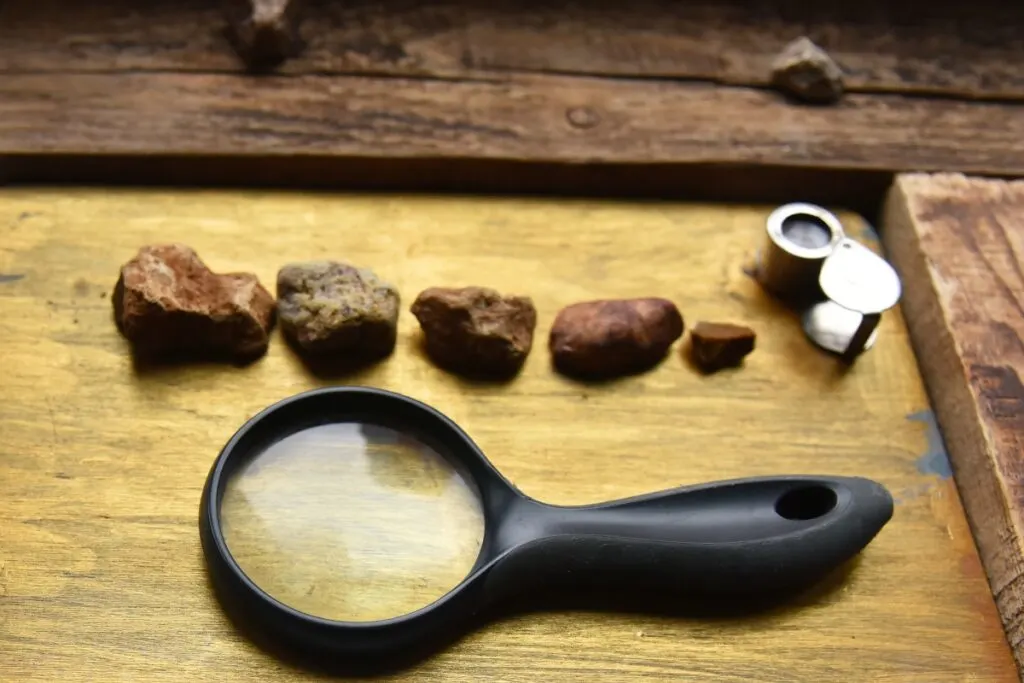
Geologists classify rocks based on their origin (genesis), mineral composition, structure and texture, and other parameters that need to be considered when addressing specific tasks. In their work, geologists use various systems of rock classification depending on the type of work being performed.
The science that studies the origin, composition, structure, classification, and transformation processes of rocks is called Petrology. Please, do not confuse it with petrography. Petrography is a narrower discipline within petrology that focuses on the detailed microscopic examination of rocks.
Let’s start with the most common classification of rocks: classification based on the formation type (genesis). According to this classification, all rocks can be divided into 3 types:
- Igneous rocks: formed from the cooling and crystallization of magma.
- Sedimentary rocks: formed when weathered fragments of other rocks are buried, compressed, and cemented together, or when minerals precipitate directly from solution.
- Metamorphic rocks: result when existing rocks are changed by heat, pressure, or reactive fluids, such as hot, mineral-laden water.
These types are further divided into subtypes.
BTW: Do you want to know more about rock and mineral identification? The books listed below are the best ones you can find on the internet (Amazon links):
- Smithsonian Handbooks: Rocks & Minerals
- Gemstone & Crystal Properties (Quick Study Home)
- Ultimate Explorer Field Guide: Rocks and Minerals (National Geographic Kids)
Igneous Rocks
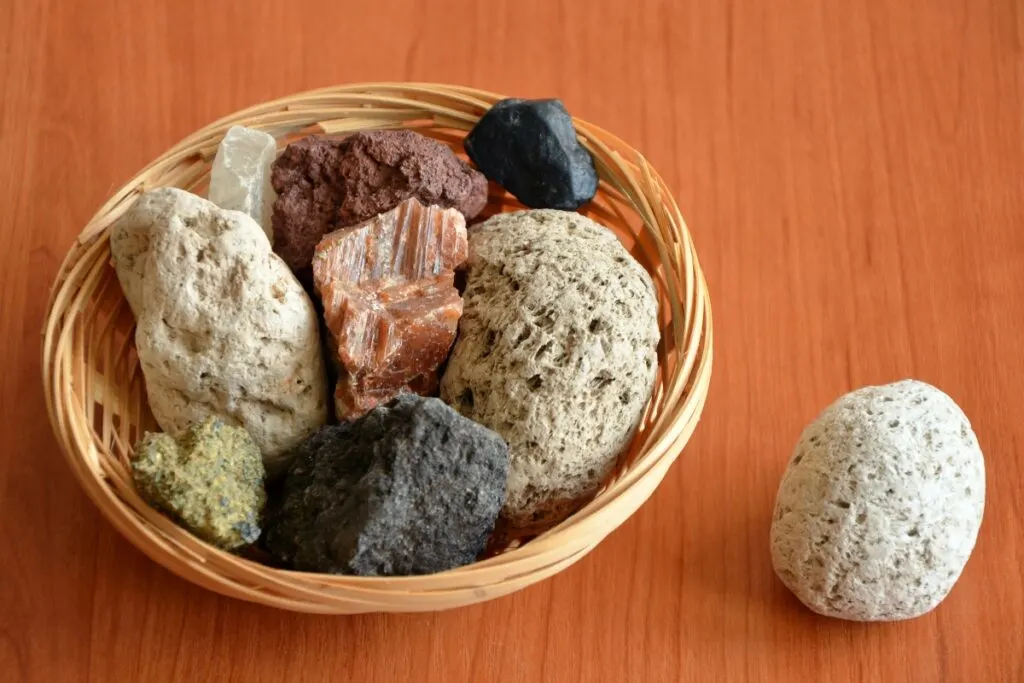
The preferred method for classifying any rock type – igneous, sedimentary, or metamorphic – is based on texture, and composition (chemical and mineral composition).
Textural Criteria
Textural criteria are commonly considered first, as textures provide the best evidence for rock origin and permit classification into the broadest genetic categories. Texture refers to the size and arrangement of mineral grains within the rock.
The first step in igneous rock description geologists determine whether the rock falls into one of the following 5 categories by texture:
- Phaneritic texture: The crystals that compose the rock are readily visible to the naked eye.
- Aphanitic texture: The crystals, if any, are too small to be seen readily by the naked eye.
- Fragmental texture: The rock is composed of pieces of disaggregated igneous material, deposited and later amalgamated.
- Glassy: Rapid cooling prevents mineral grains from forming, resulting in a glass-like texture. Example: Obsidian.
- Vesicular: Contains cavities (vesicles) formed by trapped gases. Example: Pumice.
All igneous rocks are divided into two groups according to the place of their formation relative to the Earth’s surface:
- Plutonic or intrusive rocks result when magma cools and crystallizes slowly within the Earth’s crust. If a rock exhibits phaneritic texture it crystallizes slowly beneath the surface of the Earth and is called plutonic. Examples include granite and diorite.
- Volcanic or extrusive rocks form when lava cools and solidifies on the Earth’s surface. If it is aphanitic, it crystallized rapidly at the Earth’s surface and is called volcanic. Examples include basalt and obsidian.
Fragmental rocks are collectively called pyroclastic. Pyroclastic rocks are composed of fragments ejected during explosive volcanic eruptions.
If it is glassy, vesicular, or fragmental you cannot determine mineralogy and hence the name is simply obsidian for a glass, tuff for a fragmental, or pumice/scoria for a vesicular rock.
Mineral and Chemical Composition-Based Classification
Igneous rocks are further classified based on their mineral composition, which is determined by the proportions of black and light minerals present. The main compositional categories are:
- Felsic (Acid igneous rocks): Rich in light-colored minerals, mainly quartz, and feldspar. These rocks have more than 66% SiO2 content, e.g. granite, rhyolite.
- Mafic (Basic igneous rocks): Rich in dark-colored minerals, such as pyroxene and olivine. The SiO2 content in these rocks varies between 45 to 52%, e.g. gabbro and basalt.
- Intermediate: Contains minerals between felsic and mafic compositions. These rocks have 52 to 66% of SiO2, e.g. syenite or diorite, trachyte, andesite.
- Ultramafic (Ultrabasic igneous rocks): Composed predominantly of dark-colored minerals, including olivine and pyroxene. In these rocks, SiO2 content is less than 45%. They have high Mg content, e.g. dunite, peridotite, and pyroxenite.
As you may have noticed, this system is also based on SiO2 components. The grouping of rocks on the basis of their silica contents is a chemical parameter.
This classification system is very convenient when conducting fieldwork. During fieldwork, it can be quite difficult and sometimes impossible to determine the mineral composition of the rock, so geologists are guided by the ratio of light and dark minerals.
| Composition type | Rocks name | |
|---|---|---|
| INTRUSIVE | ||
| Felsic | Granite | |
| Intermediate | Diorite, Syenite, Monzonite | |
| Mafic | Gabro | |
| Ultramafic | Peridotite, Dunite, Pyroxenite, Hornblendite | |
| EXTRUSIVE | ||
| Felsic | Rhyolite, Obsidian | |
| Intermediate | Trachyte, Andesite, Dacite | |
| Mafic | Basalt | |
| Ultramafic | – | |
TIP: Check out some interesting, fun, and scientific facts about igneous rocks, which will not leave anyone indifferent in the article below:
11 Cool & Interesting Facts About Igneous Rocks (Must Read)
Metamorphic Rocks
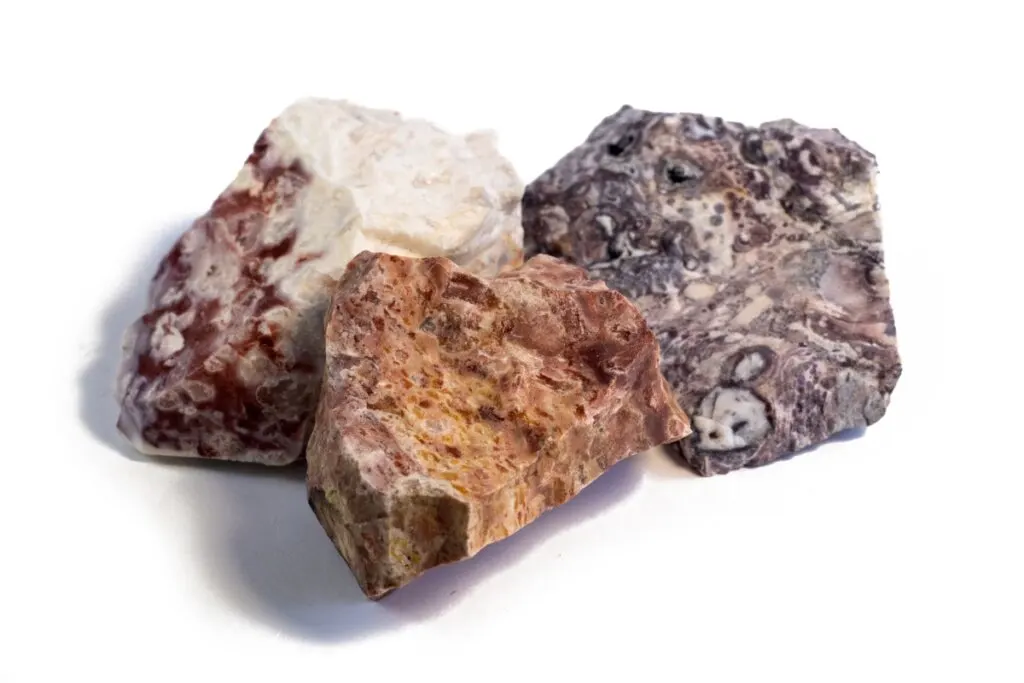
Metamorphic rocks start as one type of rock and — with pressure, heat, and time — gradually change into a new type of rock.
Geologists classify metamorphic rocks based on their texture, mineral composition, and the processes that led to their formation.
Texture-Based Classification
- Foliated:
These rocks have a layered or banded appearance due to the alignment of minerals or the presence of visible parallel planes of preferred orientation.
Examples include slate, schist, phyllite, and gneiss. These rocks formed in an environment with either directed pressure or shear stress.
- Non-foliated:
These rocks lack a layered or banded appearance and typically have a more uniform grain structure.
Examples include marble, hornfels, and quartzite. These rocks formed in an environment without direct pressure or relatively near the surface with very little pressure at all.
Metamorphic Grade-Based Classification
Metamorphic rocks can also be classified based on their metamorphic grade, which reflects the intensity of the metamorphic process.
The grade is typically determined by the temperature and pressure conditions experienced by the rock during metamorphism. Common grade-based terms include:
- Low-grade: Rocks that have undergone mild metamorphic conditions, resulting in minimal mineral changes. Examples include slate and low-grade schist.
- Medium-grade: Rocks that have experienced intermediate levels of temperature and pressure, leading to more pronounced mineral changes. Examples include medium-grade schist and amphibolite.
- High-grade: Rocks that have undergone intense metamorphism at high temperatures and pressures, resulting in significant mineral changes. Examples include gneiss and granulite.
TIP: Check out the article below if you want to also know about the classification of minerals explained by PRO geologist:
How to Guide: Classification of Minerals by PRO Geologist
Mineral Composition-Based Classification
Metamorphic rocks can also be classified based on their mineral composition, which is determined by the types of parent rocks and the specific metamorphic processes involved.
Here are some common types:
- Calcite-rich: Metamorphic rocks dominated by the mineral calcite. Examples include marble and calc-schist.
- Quartz-rich: Metamorphic rocks rich in quartz. Examples include quartzite.
- Mica-rich: Metamorphic rocks with a significant presence of mica minerals. Examples include phyllite and mica schist.
- Garnet-rich: Metamorphic rocks containing abundant garnet crystals. Examples include garnet schist and gneiss.
- Amphibole-rich: Metamorphic rocks rich in amphibole minerals. Examples include amphibolite and hornblende schist.
| Metamorphism intensity/type | Rocks name |
|---|---|
| FOLIATED | |
| Low Grade (150-450ᴼC) | Slate, Chlorite schist |
| Phyllite | |
| Medium Grade (450-550ᴼC) | Schist, Amphibole gneiss |
| High Grade (more than 550ᴼC) | Gneiss |
| NONFOLIATED | |
| Regional type of metamorphism | Antracite coal |
| Contact type of metamorphism | Hornfels |
| Regional or Contact type of metamorphism | Quartzite, Marble, Metaconglomerate |
TIP: Mineral collecting is an exciting hobby, but over time, boxes with minerals and rocks start to take up half the house, and then the collector begins to ask themselves: How can I sell samples that I don’t need? Find out a helpful guide in the article below:
5 Proven Tips on Selling Your Rock Collection (How & Where)
Sedimentary Rocks
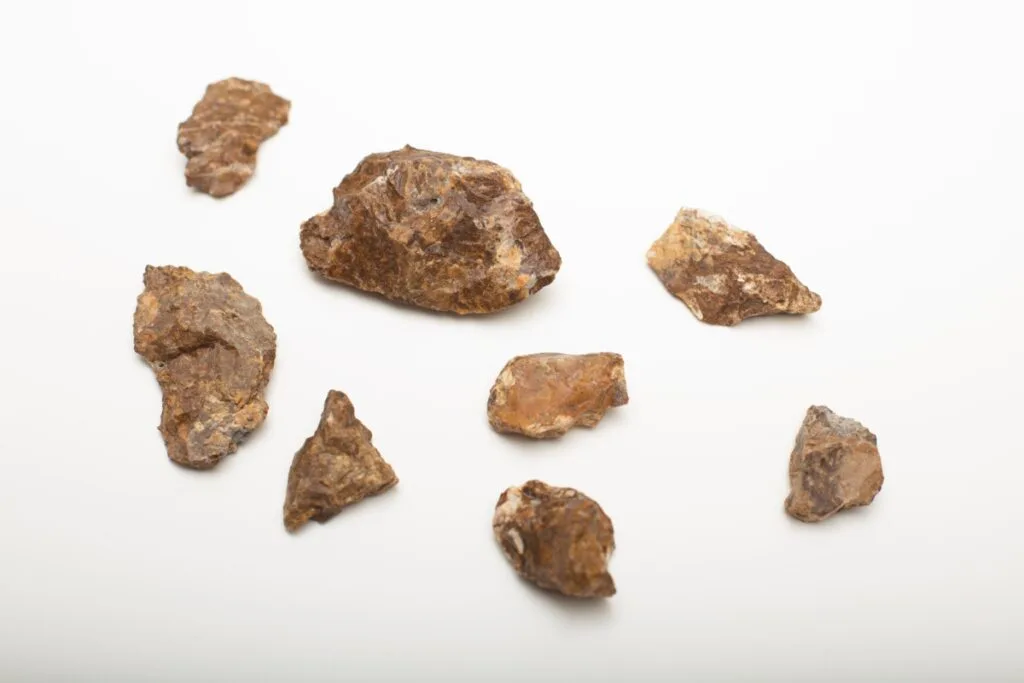
Sedimentary rocks form at low temperatures and pressures at the surface of the Earth owing to deposition by water, wind, or ice.
Sedimentary rocks are classified based on various criteria, including their texture, composition, and the processes by which they were formed. The classification of sedimentary rocks can be complex, but here are the main categories and some common types:
- Clastic (Detrital) Sedimentary Rocks are composed of fragments or grains derived from the weathering and erosion of pre-existing rocks.
They are classified based on the grain size of the particles and the dominant mineral composition:
- Conglomerate: Coarse-grained rock composed of rounded gravel-sized particles.
- Sandstone: Medium-grained rock composed of sand-sized particles.
- Siltstone: Fine-grained rock composed of silt-sized particles.
- Mudstone (including Shale): Very fine-grained rock composed of clay-sized particles.
- Chemical Sedimentary Rocks form from the precipitation or crystallization of minerals from water solutions.
They are classified based on the dominant mineral present:
- Limestone: Rock composed primarily of the mineral calcite (CaCO3).
- Dolostone: Rock composed primarily of the mineral dolomite (CaMg(CO3)2).
- Evaporites: Rocks formed by the precipitation of minerals from evaporating water bodies, such as rock salt (halite) and rock gypsum.
- Organic Sedimentary Rocks are derived from the accumulation and lithification of organic matter, such as the remains of plants or animals.
Examples are peat and coal (formed from the compaction and alteration of plant remains under specific conditions).
- Biogenic (Biochemical) Sedimentary Rocks are formed from the accumulation of organic material produced by living organisms, such as shells, coral reefs, and microscopic marine organisms:
- Chalk is composed mainly of the microscopic shells of marine plankton.
- Coquina rock is made up of loosely cemented shell fragment
- Coral reef limestone formed from the accumulation of coral skeletons.
Classification table of sedimentary rocks
| Type by genesis | Rocks name |
|---|---|
| Clastic | Conglomerate, Breccia, Sandstone, Silestone, Claystone, Shalestone |
| Biogenic and Organic | Peat, Coal, Oil Shale, Limestone, Coral Reef Limestone |
| Chemical | Chert, Dolostone, Halite, Gypsum, Ironstone, Phosphorite |
| Pyroclastic | Tuff, Ash, Agglomerate |
TIP: Fossils are always found in sedimentary rocks. Find out the complete guide on the best spots where to find fossils in the United States in the article below:
7 Spots Where You Enjoy The Best Fossil Hunting in the USA
Conclusion
Geologists classify all rocks into 3 main types based on their origin:
- Igneous rocks
- Sedimentary rocks
- Metamorphic rocks
Each group is further divided into subgroups based on texture, mineral or chemical composition, and the method/location of formation.
For example, igneous rocks are divided into intrusive (formed beneath the Earth’s surface) and extrusive (crystallized on the Earth’s surface) types.
Depending on their place of crystallization, they exhibit different textures. They are also classified based on their mineral composition into felsic, mafic, intermediate, and ultramafic.
Sedimentary rocks are classified into clastic, chemical, organic, biogenic, and other types.
Metamorphic rocks are classified based on texture into foliated and non-foliated. They are further divided based on the degree of metamorphism into low-grade, medium-grade, and high-grade metamorphism. And of course, they are categorized based on their mineral composition.
There are also other systems of rock classification. For example, in engineering geology, rocks are widely classified based on their properties such as strength, porosity, permeability, etc.
During geophysical surveys, rocks are also grouped based on their physical properties. In this article, we have presented only the most common systems of rock classification.
Sources
Petrology of sedimentary rocks – S. Boggs, Jr. 2009
Physical Geology – Thompson & Turk
General Geology – Ivanik, Menasowa, Kyiv 2020
TIP: There is a stereotypical image of a geologist walking in the mountains with a hammer and a backpack full of stones. This image was true, perhaps, a hundred years ago. Check out the modern geological tools in the article below:
The Most Common Tools Geologists Use in Labs & on Field Works
